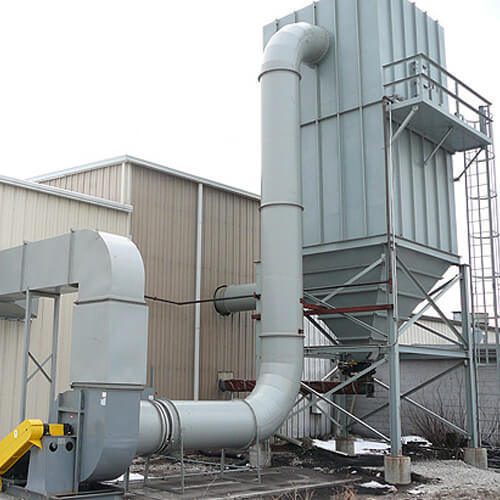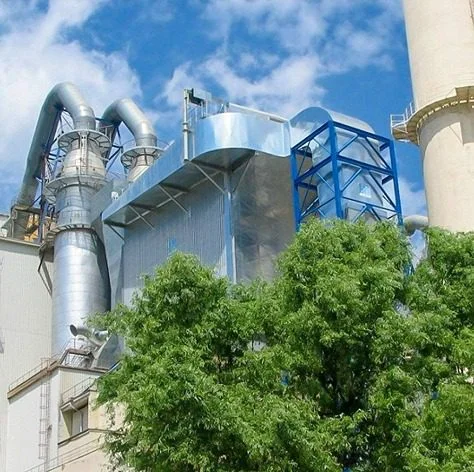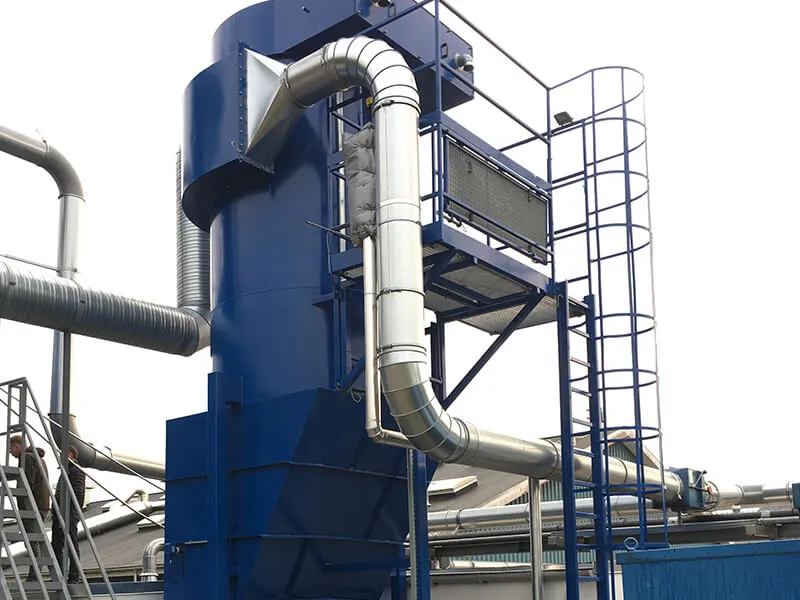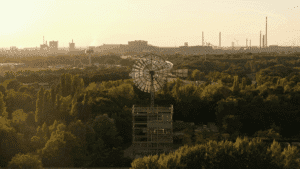Imagine an industrial facility: heavy machinery humming, materials moving, and workers performing precise tasks. Now imagine all that productivity happening in an environment filled with fine dust, chemical fumes, and microscopic particulates. For most industries, this isn’t just hypothetical—it’s a daily reality. Industrial air filtration is no longer a luxury; it is a critical component of operational safety, product quality, regulatory compliance, and sustainability.
For decision-makers in manufacturing, pharmaceuticals, food processing, or chemical production, investing in advanced air filtration is both a protective measure and a strategic business choice. Clean air means fewer equipment failures, lower health risks, and better adherence to emission regulations—ultimately translating into cost savings and enhanced reputation.
Understanding Industrial Air Filtration: What It Does
At its core, industrial air filtration removes airborne contaminants generated by industrial processes. These contaminants range from dust and metal shavings to gases, chemical fumes, and ultrafine particulates. Without proper filtration, these pollutants can settle on machinery, damage sensitive instruments, reduce product quality, or pose serious occupational health hazards.
A modern filtration system works on multiple levels. Primary filters capture larger particles, protecting equipment and structural surfaces. Secondary or high-efficiency filters target fine particles, down to sub-micron sizes, ensuring compliance with environmental and safety standards. Some systems also incorporate chemical filtration to neutralize odors, volatile organic compounds (VOCs), and corrosive gases.

Ensure Clean Air and Regulatory Compliance Today
How Industrial Air Filtration Works: Technical Perspective
Industrial air filtration is not one-size-fits-all. Systems are engineered based on the type of contaminants, volume of air to be processed, environmental conditions, and regulatory requirements.
- Mechanical Filtration: Fabric bag filters, pleated cartridges, and metal mesh filters capture particulate matter. The efficiency depends on fiber density, layering, and the surface area exposed to airflow. Baghouse filters, for example, can handle extremely high dust loads while maintaining consistent airflow.
- Electrostatic Precipitation: Electrostatic precipitators (ESPs) ionize particles and collect them on charged plates. This method is particularly effective for fine dust in high-volume exhaust streams, such as in cement or power plants. Efficiency is determined by particle size, air velocity, and electrical field strength.
- Chemical Filtration: Activated carbon or catalytic media neutralize gaseous pollutants, including VOCs and odorous compounds. Industries like chemical manufacturing or food processing rely on this stage to prevent contamination or workplace hazards.
Unlike consumer-grade filters, industrial systems are designed for continuous operation, handling hundreds of thousands of cubic meters of air per hour, while balancing pressure drop, energy efficiency, and maintenance needs.
Key Functional Considerations for Businesses
From a B2B perspective, decision-makers are concerned with more than just filtration efficiency. They want solutions that optimize operational cost, maintenance, compliance, and long-term reliability.
Air filtration systems must be evaluated based on:
- Capacity and Scalability: Can the system handle peak emissions without performance drop? Does it allow modular expansion as production scales?
- Maintenance Efficiency: Self-cleaning mechanisms, pulse-jet bag filters, and automated monitoring reduce downtime and labor costs.
- Pagkonsumo ng Enerhiya: A well-engineered system minimizes fan power requirements and maintains low pressure drop while preserving filtration efficiency.
- Pagtitiyak sa Pagsunod: The system should reliably meet local and international air quality standards. For instance, industrial baghouse filters in cement plants often aim for particulate emissions below 30 mg/Nm³, aligning with global regulations.
Mga Application sa Buong Industriya
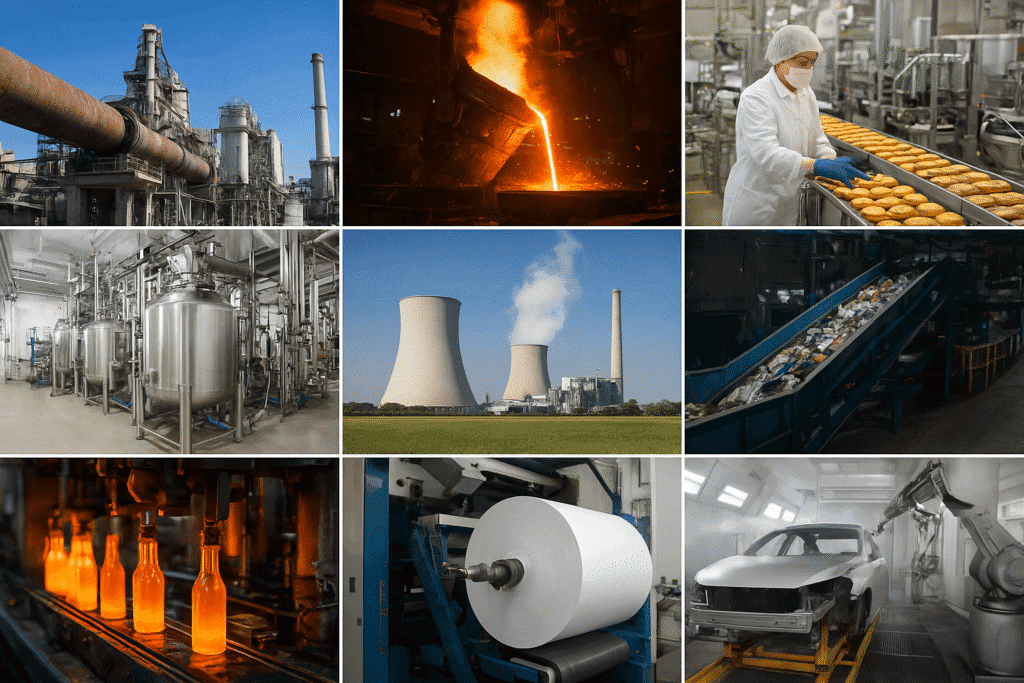
Industrial air filtration plays a critical role wherever airborne contaminants are generated, but the specific requirements vary significantly depending on the type of industrial process, the materials handled, and the applicable regulatory standards. Choosing the right system is not just about removing dust—it’s about protecting workers, ensuring product quality, maintaining equipment, and complying with environmental laws.
Pharmaceuticals and Biotechnology
In pharmaceutical and biotech facilities, even microscopic particles can compromise sterile production environments. Industrial air filtration here goes beyond basic dust removal. HEPA (High-Efficiency Particulate Air) and ULPA (Ultra-Low Penetration Air) filters are standard, capable of removing up to 99.999% of particles as small as 0.12 microns. These systems must comply with strict validation protocols under ISO 14644 standards for cleanrooms, ensuring consistent airflow, differential pressure control, and particle counts within acceptable limits. Continuous monitoring and filter integrity testing are often required to guarantee both product safety and regulatory compliance.
Food and Beverage Industry
Food processing and beverage production demand precise control over airborne particulates to prevent contamination, maintain hygiene, and comply with local and international food safety standards such as HACCP o ISO 22000. Industrial air filtration systems in these settings handle dust from grains, powders, or packaging materials, as well as odors and fumes. Advanced filtration units are often integrated directly into cleanroom setups or production lines to maintain a controlled environment without disrupting workflow. Systems may also include chemical filtration for odor neutralization, particularly in meat, dairy, or fermentation processes.
Metal Processing and Power Generation
Industries such as steel, aluminum, and power generation generate extremely high volumes of dust and fine particulates, often at elevated temperatures. Air filtration solutions here must be robust and durable. Baghouse filters, cartridge filters, and electrostatic precipitators (ESPs) are commonly deployed to capture abrasive dust without damaging equipment or reducing airflow efficiency. The systems are designed to withstand high temperatures and handle varying dust loads while minimizing pressure drop and energy consumption. Real-time monitoring is often integrated to ensure consistent performance, prevent equipment wear, and meet environmental emissions standards.
Paggawa ng Kemikal
Chemical plants deal with complex challenges, including toxic fumes, volatile organic compounds (VOCs), corrosive gases, and fine particulate matter. Industrial air filtration in these environments must neutralize chemical hazards while maintaining uninterrupted airflow to production processes. Activated carbon filters, catalytic scrubbers, and high-efficiency particulate filters are commonly combined in multi-stage systems to provide comprehensive protection. Filtration design must also consider chemical reactivity, humidity levels, and temperature, ensuring both safety for workers and compliance with environmental and workplace safety regulations such as OSHA or EPA standards.
Future Outlook: Technology and Industry Trends
Industrial air filtration is evolving rapidly with technology and sustainability in mind. Decision-makers now seek solutions that not only meet present needs but also anticipate future challenges:
- Smart Monitoring and Predictive Maintenance: IoT sensors now track filter performance, airflow, and dust load in real time, allowing predictive maintenance and reduced unplanned downtime.
- Hybrid Filtration Media: New materials combine mechanical and electrostatic capture in one medium, increasing efficiency against ultrafine particles and nanoparticles.
- Mga Sustainable na Kasanayan: Energy-efficient designs and biodegradable or recyclable filter media reduce operational costs and environmental impact.
- Integration with Facility Management Systems: Advanced filters are now designed to communicate with central building management or process control systems, optimizing air quality without compromising production.
Tuklasin ang Aming Saklaw ng Mga Solusyon:
Conclusion: Air Filtration as a Strategic Asset
Industrial air filtration is far more than a regulatory checkbox—it is a strategic asset for operational excellence, worker safety, and environmental responsibility. Modern systems offer technological intelligence, energy efficiency, and long-term reliability, providing measurable benefits across industries.
For commercial decision-makers looking to invest wisely, Intensiv-Filter Himenviro delivers advanced, customizable solutions designed to meet diverse industrial needs. Partnering with experts ensures optimized air quality, compliance assurance, and operational continuity, all while future-proofing your facility against evolving environmental and technological demands.
Next Steps
Evaluate your facility’s air quality needs today. Engage with Intensiv-Filter Himenviro for tailored industrial filtration solutions that combine technical expertise, innovative design, and proven performance. Clean air is not just a requirement—it is a competitive advantage.
Mga Madalas Itanong
Industrial air filtration is the process of removing airborne contaminants—such as dust, fumes, and gases—from industrial workspaces or exhaust streams. It is crucial for protecting worker health, ensuring equipment longevity, maintaining product quality, and meeting environmental regulations.
Industries with airborne contaminants, including pharmaceuticals, food and beverage, chemical manufacturing, metal processing, power generation, and cement production, require specialized filtration systems tailored to their specific processes and regulatory standards.
System selection depends on contaminant type, particle size, airflow volume, environmental conditions (temperature, humidity, chemical exposure), and compliance requirements. A detailed site assessment is recommended to determine the optimal solution.

